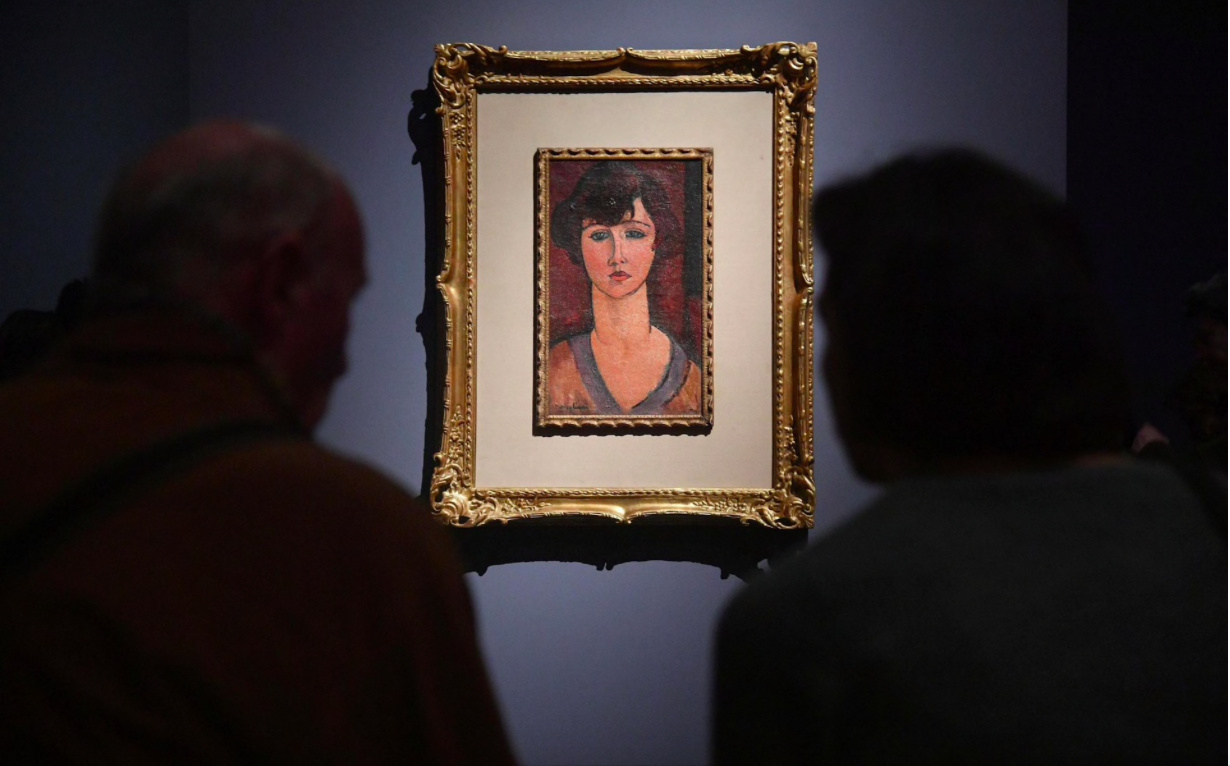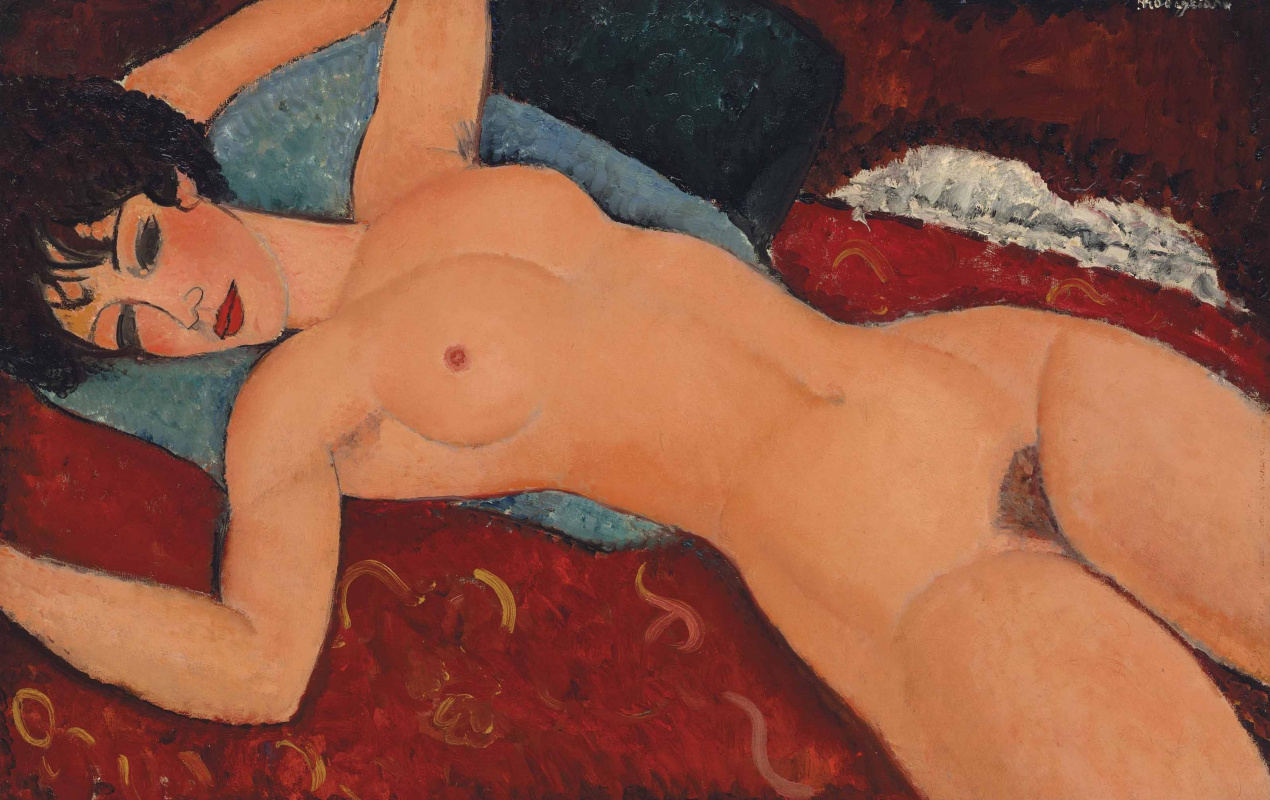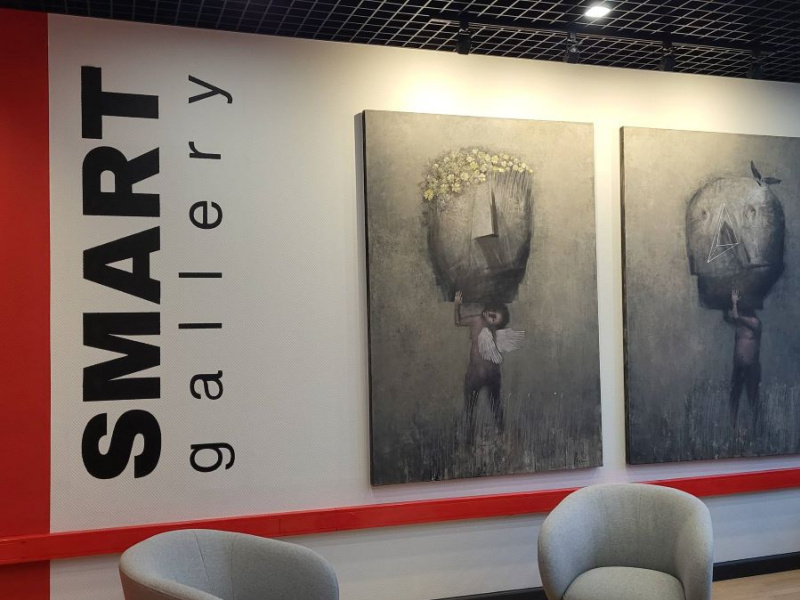Two thirds of Modigliani paintings exhibited at Genoa’s Palazzo Ducale during four months in 2017 have been declared fake by the expert appointed by a Genoa court in a prosecutor’s probe started three days prior the scheduled closing of the show. The Italian news agency ANSA reported that 20 out of 21 oil paintings under police concerns were just being confirmed as forgeries.

The pompous opening of the display at the Genoa’s Ducale Palace attracted hundreds of thousands of visitors. People have been paying money to view 30 art works by Amedeo Modigliani, a renowned Italian artist of the 20th century. On the eve of the show’s opening in March 2017, the exhibition curator Rudy Chiappini told The Associated Press: "Setting up an exhibition of Amedeo Modigliani is always a new adventure." Well, now we know that it is indeed so.
First who raised doubts about the authenticity of the exhibits presented in Ducale Palace was Carlo Pepi, a notable 79-year-old Tuscan art critic and collector who still has a keen eye to spot fakes. He has expressed his hunches a month before the exhibition had opened, after viewing its promo that featured a new version of the Marie, Daughter of the People, a 1918 portrait.
Carlo Pepi told The Telegraph, "A Michelangelo is a Michelangelo. A Picasso is a Picasso. But when a painting is a fake, it is missing its soul, and these were missing that three-dimensional elegance of Modigliani." He concluded, "Even a child could see these were crude fakes."
The forgery of works attributed to Modigliani breaks every possible records by now. First, because prices for his artworks drastically rocketed since 2010. They reached figures for works by Pablo Picasso, Francis Bacon, Edvard Munch, Alberto Giacometti, and Andy Warhol. Now Modigliani joined the rest five artists in the exclusive $100 Million Club.
The stakes are high and bids are only getting higher. Liu Yiqian, one of China’s leading art collectors, who once was a driver but built a fortune in the stock market, has paid $170.4 million in 2015 at Christie’s in New York for a Modigliani painting, Nu Couché (Reclining Nude).
It beat the previous record of an artist, which was $70.7 million, paid at Sotheby’s in 2014 for a carved-stone head of a woman and $52 million for a Modigliani sculpture at a Christie’s sale in Paris in 2010, which exceeded the estimate 10 times.
The stakes are high and bids are only getting higher. Liu Yiqian, one of China’s leading art collectors, who once was a driver but built a fortune in the stock market, has paid $170.4 million in 2015 at Christie’s in New York for a Modigliani painting, Nu Couché (Reclining Nude).
It beat the previous record of an artist, which was $70.7 million, paid at Sotheby’s in 2014 for a carved-stone head of a woman and $52 million for a Modigliani sculpture at a Christie’s sale in Paris in 2010, which exceeded the estimate 10 times.

The sale of Modigliani’s Nu Couché (1917−18) at Christie’s in New York in 2015. Photo: Timothy A. Clary/AFP/Getty Images.
Second, the Modigliani market is beset with problems in defining the exact number of art works and their provenance.
Early in the 20th-century, Jewish in origin, Italian artist and sculptor suffered from ill health and drug and alcohol abuse, and struggled to sell his paintings to get by. In his youth, after studies at art schools in Venice and Florence, in 1906 he went to live the life of a bohemian in Paris at the Bateau Lavoir, the ramshackle studio in Montmartre where Picasso and other artists and writers stayed. There is an anecdotal legend saying that the artist often walked the streets of Paris with his portfolio and gave away his sketches, sometimes in exchange for meals or drinks in restaurants.
Modigliani became well-known for his distinctive style of painting—figures with elongated necks, almond eyes, oval faces, and button mouths. However, his only solo exhibition, held in Paris in 1917, was raided by the police on the grounds of indecency. The place where the display was organized was across the street from a police station, and some nudes placed in the window of the gallery did not impress the police chief. He shouted, "Those nudes, they have pubic hair!" and sent an officer to insist that the paintings be removed. One of the nudes in the window is believed to have been Nu Couché, sold for $170.4 million in 2015 at Christie’s.
Early in the 20th-century, Jewish in origin, Italian artist and sculptor suffered from ill health and drug and alcohol abuse, and struggled to sell his paintings to get by. In his youth, after studies at art schools in Venice and Florence, in 1906 he went to live the life of a bohemian in Paris at the Bateau Lavoir, the ramshackle studio in Montmartre where Picasso and other artists and writers stayed. There is an anecdotal legend saying that the artist often walked the streets of Paris with his portfolio and gave away his sketches, sometimes in exchange for meals or drinks in restaurants.
Modigliani became well-known for his distinctive style of painting—figures with elongated necks, almond eyes, oval faces, and button mouths. However, his only solo exhibition, held in Paris in 1917, was raided by the police on the grounds of indecency. The place where the display was organized was across the street from a police station, and some nudes placed in the window of the gallery did not impress the police chief. He shouted, "Those nudes, they have pubic hair!" and sent an officer to insist that the paintings be removed. One of the nudes in the window is believed to have been Nu Couché, sold for $170.4 million in 2015 at Christie’s.
Reclining Nude
1917, 92×60 cm
Modigliani died of tubercular meningitis in 1920, aged 35. Experts estimated that around 350 of his paintings are in existence today.
Art critic Carlo Pepi has been spotting Modigliani art forgery for decades and its scope infuriated him much. So, at the exhibition in Genoa he called it out publicly — he filed a formal complaint with the Carabinieri art fraud unit in Rome. And the display was eventually closed in July 2017, 3 days prior to its scheduled closing with the paintings handed over to investigators.
Art critic Carlo Pepi has been spotting Modigliani art forgery for decades and its scope infuriated him much. So, at the exhibition in Genoa he called it out publicly — he filed a formal complaint with the Carabinieri art fraud unit in Rome. And the display was eventually closed in July 2017, 3 days prior to its scheduled closing with the paintings handed over to investigators.

Carlo Pepi. Photo: credit LIVORNO.
Carlo Pepi was triumphant: "Finally the bubble has burst. I have been fighting against the forgery of Modiglianis for years, and have been opposed and even persecuted by the art establishment. Modigliani seemed to have painted more pictures after death than when he was alive; it was an absurd situation. But this is just the tip of the iceberg".

Oil painting, attributed to Modigliani, on display in Genoa. Photo credit: ANSA
Carlo Pepi’s action received support from a French art historian and Modigliani expert Marc Restellini, who first called the Genoa exhibition "dubious" and then claimed to counter forgery, "It is indisputable that the works are fakes and I have presented the proof. I’ve given all the information in my possession to the Carabinieri in order to explain how this counterfeiting system works."
‘It's good, bad, ugly, and bizarre," Kenneth Wayne, another world’s leading Modigliani scholar, said at a recent symposium at New York University on fakes, forgeries, and stolen art. "To say that the catalogue raisonné situation of works by Modigliani is a mess is an understatement."
Marc Restellini, a famous curator and an art-world rebel who has organized Modigliani exhibitions around the world, believes that there are "at least 1,000 Modigliani fakes in the world."
To improve the bizarre mess in Modigliani catalogue raisonné is a question of life or death for him. And in his case it’s not just a figurative expression. He claimed to have received death threats from collectors when he embarked on it in 2006. But he does not scare easily. Instead, he has revised the only annotated catalogue of Modigliani by the respected critic Ambrosia Ceroni, published in 1972, has added about a hundred works to the 337 that Ceroni recorded and de-authenticated a handful.
To improve the bizarre mess in Modigliani catalogue raisonné is a question of life or death for him. And in his case it’s not just a figurative expression. He claimed to have received death threats from collectors when he embarked on it in 2006. But he does not scare easily. Instead, he has revised the only annotated catalogue of Modigliani by the respected critic Ambrosia Ceroni, published in 1972, has added about a hundred works to the 337 that Ceroni recorded and de-authenticated a handful.

Marc Restellini, in front of his Pinacotheque de Paris, a small, private exhibition space he opened in 2007. Its popularity was seen as an affront to France’s state-financed cultural establishment. It closed in February 2016 following a massive drop in attendance after the tragic Parisian terrorist attacks of November 2015. Photo: Loic Venance/2010 AFP/Getty Images.
As to the official court-appointed expert Isabella Quattrocchi, she didn’t immediately respond to a request for comment. Italian news reported that she said in a statement delivered to prosecutors that the paintings in question were "blatantly falsified" in terms "both for the pigment and for the style". She also added that the frames "originated in countries of eastern Europe and the United States" and they "have nothing to do, either in context or in historical period, with Modigliani."
Well, her comment perplexed art historians a bit, for when authenticating an art work, the frames should be irrelevant. And considering that most of the paintings under suspicion belong to an American collector, Joseph Guttmann, there could be no questions why they were produced in the USA.
Well, her comment perplexed art historians a bit, for when authenticating an art work, the frames should be irrelevant. And considering that most of the paintings under suspicion belong to an American collector, Joseph Guttmann, there could be no questions why they were produced in the USA.

One of the paintings at the exhibition at the Palazzo Ducale in Genoa in March 2017. Photo credit: ANSA
And now about the official probe. Three people are now under investigation, including the exhibition’s curator, Rudy Chiappini; Massimo Vitta Zelman, president of MondoMostre Skira, a third party which organized the exhibition at Palazzo Ducale; and U.S. art dealer Joseph Guttmann, who loaned some of the forged works to the show.
Following the scandalous closing of the exhibition in Genoa, the curators rejected the doubts raised by the scholars and defended their work. Rudy Chiappini, a recognized curator of international exhibitions, said that they’ve made a prudential selection and have not came up with any new attributions. He claimed that they have used reports of unpublished works, not being succumbed into the flattering of any new canvases' discoveries.
Mr. Chiappini also stressed that he was not responsible for attributing the works to Modigliani: "I collected the information and documentation that was submitted to me for each canvas. If there has been any wrongdoing, we will need to go back to the original source of those attributions. Until proven otherwise, I remain convinced that the works are originals. And that story of the frames is ridiculous". The curators presented a 90-page dossier to the prosecutor’s office.
Massimo Vitta Zellman, the president of MondoMostra Skira, the largest organizer and producer of exhibitions in Italy, to which Palazzo Ducale had commissioned selection of works and organization of the show, said in his defense: "We have organized five exhibitions on Modigliani, we have relied on the opinions of the museum community".
Following the scandalous closing of the exhibition in Genoa, the curators rejected the doubts raised by the scholars and defended their work. Rudy Chiappini, a recognized curator of international exhibitions, said that they’ve made a prudential selection and have not came up with any new attributions. He claimed that they have used reports of unpublished works, not being succumbed into the flattering of any new canvases' discoveries.
Mr. Chiappini also stressed that he was not responsible for attributing the works to Modigliani: "I collected the information and documentation that was submitted to me for each canvas. If there has been any wrongdoing, we will need to go back to the original source of those attributions. Until proven otherwise, I remain convinced that the works are originals. And that story of the frames is ridiculous". The curators presented a 90-page dossier to the prosecutor’s office.
Massimo Vitta Zellman, the president of MondoMostra Skira, the largest organizer and producer of exhibitions in Italy, to which Palazzo Ducale had commissioned selection of works and organization of the show, said in his defense: "We have organized five exhibitions on Modigliani, we have relied on the opinions of the museum community".

Left to right: Stefano Zuffi, art historian and curator of the exhibition; Rudy Chiappini, art critic and curator of the exhibition, Vita Zelmann Massimo, president of MondoMostra Skira; Luca Borzani, president of Palazzo Ducale, during a press conference following the controversial accusations in showing fakes, Genoa, 5 June 2017. Photo credit: Luca Zennaro, ANSA.
The sensational statement of the state-appointed expert that denounced 20 works attributed to Modigliani as worthless fakes does not mean that the Modigliani case is being solved. Instead, it has now entered a new spiral, provoking further investigations and filing new cases in court.
For instance, consumer advocate Furio Truzzi urged visitors of the Modigliani exhibition at Palazzo Ducale to seek refunds based on fraud. His organization set up a hotline last Wednesday so that people who bought tickets or traveled to Genoa to see the show would be able to demand refund. Well, it makes sense. Why should they pay from 3 to 13 euro for seeing a worthless daubs?
The fakes' owners are unlikely to sit back and watch their investment go up in smoke as well. They are just bound to respond with expert assessments of their own. And who knows what we are about to learn from them soon…
For instance, consumer advocate Furio Truzzi urged visitors of the Modigliani exhibition at Palazzo Ducale to seek refunds based on fraud. His organization set up a hotline last Wednesday so that people who bought tickets or traveled to Genoa to see the show would be able to demand refund. Well, it makes sense. Why should they pay from 3 to 13 euro for seeing a worthless daubs?
The fakes' owners are unlikely to sit back and watch their investment go up in smoke as well. They are just bound to respond with expert assessments of their own. And who knows what we are about to learn from them soon…

A view of the painting Cariatide Rossa, attributed in an exhibit at the Ducal Palace in Genoa, Italy, to Amedeo Modigliani. Photo credit: Luca Zennaro, ANSA via AP.
Written on materials of Palazzo Ducale, ANSA, Corriere Della Sera, the Telegraph, Independent, the Washington Post, Vanity Fair, BBC News, The Denver Post, Architectural Diges. Title illustration: photoshop of the Modigliani exhibition poster
at Palazzo Ducale in Genoa, Italy by Natalia Korchina.










